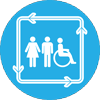- Forum
- categories
- Sanitation systems
- Shared toilets, community toilets, public toilets
- Female-Friendly Public and Community Toilets: A Guide for Planners and Decision-Maker
Female-Friendly Public and Community Toilets: A Guide for Planners and Decision-Maker
192 views
- AjitSeshadri
-

- Marine Chief Engineer by profession (1971- present) and at present Faculty in Marine Engg. Deptt. Vels University, Chennai, India. Also proficient in giving Environmental solutions , Designation- Prof. Ajit Seshadri, Head- Environment, The Vigyan Vijay Foundation, NGO, New Delhi, INDIA , Consultant located at present at Chennai, India
Re: Female-Friendly Public and Community Toilets: A Guide for Planners and Decision-Maker
Dear SuSANA Members
Greetings to All.
In All Cities and Villages, we have inadequacy of Toilet facilities for Women.
In the Best interest of Communities, it's needed to provide apt toilet and RestRoom facilities for Women in communities.
We have Schools, Colleges and other Educational Institutions, All these locations need provide easy accessible provision for women in communities.
Govt of India needs to issue Institutions to various Authorities to make available these facilities to needy Women at all times.
With Best wishes to All Members
Greetings to All.
In All Cities and Villages, we have inadequacy of Toilet facilities for Women.
In the Best interest of Communities, it's needed to provide apt toilet and RestRoom facilities for Women in communities.
We have Schools, Colleges and other Educational Institutions, All these locations need provide easy accessible provision for women in communities.
Govt of India needs to issue Institutions to various Authorities to make available these facilities to needy Women at all times.
With Best wishes to All Members
Prof. Ajit Seshadri, Faculty in Marine Engg. Deptt. Vels University, and
Head-Environment , VigyanVijay Foundation, Consultant (Water shed Mngmnt, WWT, WASH, others)Located at present at Chennai, India
Head-Environment , VigyanVijay Foundation, Consultant (Water shed Mngmnt, WWT, WASH, others)Located at present at Chennai, India
Please Log in to join the conversation.
You need to login to replyFemale-Friendly Public and Community Toilets: A Guide for Planners and Decision-Maker
Female-Friendly Public and Community Toilets: A Guide for Planners and Decision-Makers
This publication presents a practical framework for designing, building, and managing female-friendly public and community toilets—ensuring that sanitation facilities respond to the real needs of women and girls in urban settings.
About the study:
The study was jointly developed by WaterAid, WSUP (Water & Sanitation for the Urban Poor), and UNICEF to provide actionable guidance for planners, engineers, architects, and municipal decision-makers. It combines field research, design recommendations, and policy insights to make sanitation infrastructure more inclusive and safe for all users, especially women, adolescent girls, and people with disabilities.
UMC’s contribution:
The Urban Management Centre (UMC) contributed to the study as a technical partner, supporting field-level assessments, contextualising design standards for Indian cities, and facilitating knowledge dissemination through its practitioner networks and capacity-building programmes. UMC has also hosted the publication on its knowledge portal to promote accessibility and adoption by urban local bodies.
What it covers:
• Key principles and design checklists for inclusive toilet infrastructure
• Governance models and O&M frameworks for sustainability
• Safety, accessibility, and menstrual hygiene management (MHM) considerations
• Case examples from India and other developing contexts
• Tools for integrating gender-responsive design into municipal planning
Why it matters:
Access to safe, private, and well-maintained sanitation facilities is a basic right. This guide enables governments and practitioners to mainstream gender-sensitive sanitation design into urban development policies—advancing SDG 6 (Clean Water and Sanitation), SDG 5 (Gender Equality), and SDG 11 (Sustainable Cities and Communities).
📘 Download the full publication here
📅 Published: 2018
Authored by: WaterAid, WSUP, and UNICEF
Technical Partner: Urban Management Centre (UMC)
SuSanA members are invited to share examples of female-friendly sanitation designs, inclusive policies, and implementation experiences from their own contexts.
— *Meghna Malhotra*
Deputy Director, Urban Management Centre (UMC), India
This publication presents a practical framework for designing, building, and managing female-friendly public and community toilets—ensuring that sanitation facilities respond to the real needs of women and girls in urban settings.
About the study:
The study was jointly developed by WaterAid, WSUP (Water & Sanitation for the Urban Poor), and UNICEF to provide actionable guidance for planners, engineers, architects, and municipal decision-makers. It combines field research, design recommendations, and policy insights to make sanitation infrastructure more inclusive and safe for all users, especially women, adolescent girls, and people with disabilities.
UMC’s contribution:
The Urban Management Centre (UMC) contributed to the study as a technical partner, supporting field-level assessments, contextualising design standards for Indian cities, and facilitating knowledge dissemination through its practitioner networks and capacity-building programmes. UMC has also hosted the publication on its knowledge portal to promote accessibility and adoption by urban local bodies.
What it covers:
• Key principles and design checklists for inclusive toilet infrastructure
• Governance models and O&M frameworks for sustainability
• Safety, accessibility, and menstrual hygiene management (MHM) considerations
• Case examples from India and other developing contexts
• Tools for integrating gender-responsive design into municipal planning
Why it matters:
Access to safe, private, and well-maintained sanitation facilities is a basic right. This guide enables governments and practitioners to mainstream gender-sensitive sanitation design into urban development policies—advancing SDG 6 (Clean Water and Sanitation), SDG 5 (Gender Equality), and SDG 11 (Sustainable Cities and Communities).
📘 Download the full publication here
📅 Published: 2018
Authored by: WaterAid, WSUP, and UNICEF
Technical Partner: Urban Management Centre (UMC)
SuSanA members are invited to share examples of female-friendly sanitation designs, inclusive policies, and implementation experiences from their own contexts.
— *Meghna Malhotra*
Deputy Director, Urban Management Centre (UMC), India
Meghna Malhotra
Deputy Director, Urban Management Centre (UMC) – Ahmedabad, India
Urban Management Centre (UMC) is a not-for-profit organisation working with national and state governments to build capacities for inclusive and resilient urban governance.
Over the past decade, UMC has supported transformative sanitation initiatives such as:
• Garima (Odisha) – ensuring safety, dignity, and inclusion of sanitation workers
• Sanitation Workers Development Scheme (Tamil Nadu) – institutionalising welfare systems
• NAMASTE – supporting the national mission for sanitation worker empowerment
• City Livelihoods Action Plans (CLAP) – integrating urban livelihoods and gender inclusion
Visit: www.umcasia.org
Follow us: LinkedIn – Urban Management Centre
Deputy Director, Urban Management Centre (UMC) – Ahmedabad, India
Urban Management Centre (UMC) is a not-for-profit organisation working with national and state governments to build capacities for inclusive and resilient urban governance.
Over the past decade, UMC has supported transformative sanitation initiatives such as:
• Garima (Odisha) – ensuring safety, dignity, and inclusion of sanitation workers
• Sanitation Workers Development Scheme (Tamil Nadu) – institutionalising welfare systems
• NAMASTE – supporting the national mission for sanitation worker empowerment
• City Livelihoods Action Plans (CLAP) – integrating urban livelihoods and gender inclusion
Visit: www.umcasia.org
Follow us: LinkedIn – Urban Management Centre
The following user(s) like this post: AjitSeshadri
Please Log in to join the conversation.
You need to login to reply
Share this thread:
- Forum
- categories
- Sanitation systems
- Shared toilets, community toilets, public toilets
- Female-Friendly Public and Community Toilets: A Guide for Planners and Decision-Maker
Recently active users. Who else has been active?
Time to create page: 0.073 seconds







